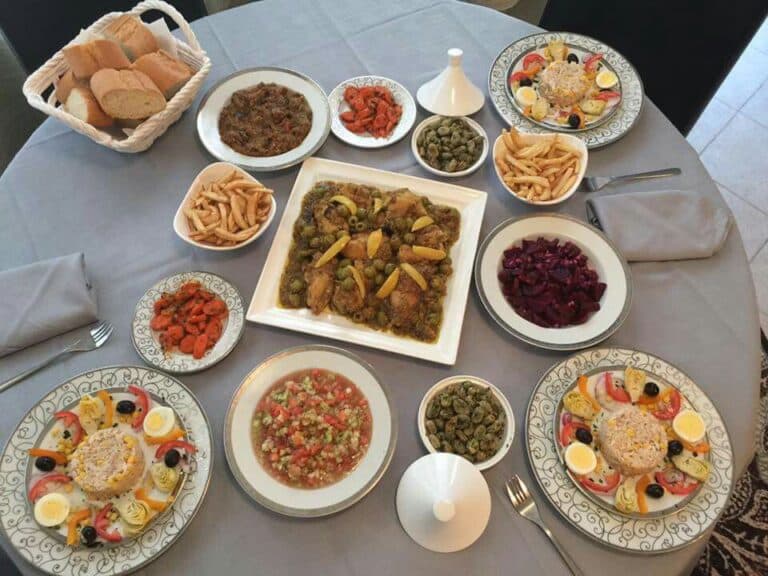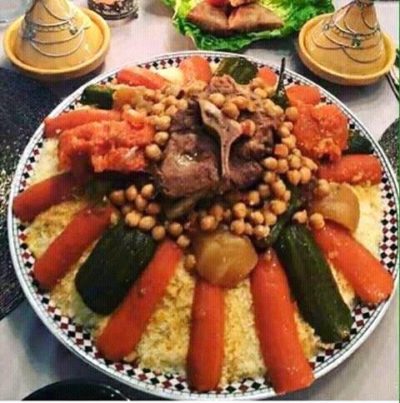Discover the Rich Diversity of Moroccan Cuisine: From Tagines to Mint Tea, Unveiling the Secrets of a Flavorful Cuisine”
Moroccan food is known for its bold and complex flavors, as well as its use of aromatic spices, herbs, and fresh ingredients. From savory stews cooked in earthenware pots to flaky pastries filled with almond paste, Moroccan cuisine is diverse and delicious.
In this article, we’ll explore some of the categories of recipes and food that are commonly found in Moroccan cuisine.
Appetizers
Moroccan cuisine has a variety of appetizers that are often served with bread or as part of a meze-style meal. Baba ghanoush, hummus, and zaalouk are all popular Moroccan appetizers.
Baba ghanoush is a roasted eggplant dip that is similar to the Middle Eastern dip, baba ganoush. The eggplant is roasted until tender, then blended with tahini, lemon juice, garlic, and olive oil.
Hummus is a chickpea dip that is often flavored with garlic, lemon, and tahini. In Morocco, hummus is sometimes made with white beans instead of chickpeas.
Zaalouk is a cooked salad made from eggplant and tomatoes that is seasoned with garlic, cumin, and paprika. It is typically served cold or at room temperature.
Main Dishes
Tagine is perhaps the most well-known Moroccan dish. It is a slow-cooked stew that is traditionally made in an earthenware pot with a conical lid, which gives it its name. The lid traps in the steam, which helps to tenderize the meat and infuse the dish with flavor. Tagines can be made with a variety of meats, including lamb, beef, chicken, and fish, as well as vegetables.
Couscous is another staple of Moroccan cuisine. It is a small, grain-like pasta that is often served with a stew of vegetables and meat. In Morocco, couscous is traditionally made by steaming it in a special pot called a couscoussière, which consists of a steamer basket that sits on top of a pot of simmering broth.
Bastilla is a savory pastry that is often served as a main course. It is typically filled with shredded chicken or seafood that has been seasoned with cinnamon, ginger, and saffron, as well as almonds and eggs.
Salads
Moroccan cuisine has a variety of salads that use fresh vegetables and herbs. Moroccan carrot salad is a popular salad that is made with grated carrots, raisins, and a dressing of lemon juice, honey, and cinnamon. Zaalouk, the cooked eggplant and tomato salad mentioned earlier, can also be served as a salad.
Orange and olive salad is another popular Moroccan salad. It is made with sliced oranges, green olives, and red onion, and is dressed with olive oil, lemon juice, and ground cumin.
Breads
Bread is an important part of Moroccan cuisine, and there are many different types of breads that are served with meals. Khobz is a round, flatbread that is often used to scoop up stews and sauces. Msemen is a flaky, layered bread that is typically served for breakfast or as a snack. Batbout is a soft, puffy bread that is often used to make sandwiches.
Desserts
Moroccan desserts often use nuts, honey, and spices like cinnamon and cardamom. Almond briouats are a type of pastry that is filled with almond paste, fried, and then dusted with powdered sugar. Chebakia is a fried cookie that is shaped into a flower and flavored with honey, sesame seeds, and anise. M’hanncha
also known as snake cake, is a pastry that is shaped like a coiled snake and filled with a mixture of almond paste and orange blossom water.
Another popular Moroccan dessert is the pastilla, a sweet pastry filled with almonds, cinnamon, and sugar. It is often served with a dusting of powdered sugar or a drizzle of honey.
Beverages
Mint tea, also known as Moroccan tea, is a staple of Moroccan cuisine. It is made with gunpowder green tea and fresh mint leaves, and is sweetened with sugar. It is often served in a small glass, and the pouring of the tea is a traditional part of Moroccan hospitality.
Another popular Moroccan beverage is qahwa, a type of coffee that is flavored with spices like cinnamon, ginger, and cardamom. It is often served with dates or sweet pastries.
Condiments
Harissa is a spicy red pepper paste that is often used as a condiment in Moroccan cuisine. It is made from roasted red peppers, garlic, and a variety of spices, and is traditionally used to add heat to stews and soups.
Chermoula is a marinade that is often used to flavor fish and seafood dishes. It is made from a combination of herbs, spices, garlic, and lemon juice, and is typically used to marinate fish before grilling or roasting.
Preserved lemons are another common condiment in Moroccan cuisine. They are made by packing lemons in salt and leaving them to ferment for several weeks. The resulting preserved lemons are used to add a tangy, citrusy flavor to dishes like tagines and couscous.
Moroccan cuisine is a vibrant and diverse cuisine that is known for its bold flavors and unique combinations of spices and ingredients. From savory stews to sweet pastries, Moroccan cuisine offers a wide range of dishes that reflect the country’s history, geography, and cultural influences. Whether you’re a fan of hearty meat dishes or vegetarian options, there is something for everyone in Moroccan cuisine. By exploring the different categories of recipes and food that are commonly found in Moroccan cuisine, you can discover a whole new world of flavors and textures that will delight your taste buds and expand your culinary horizons.


